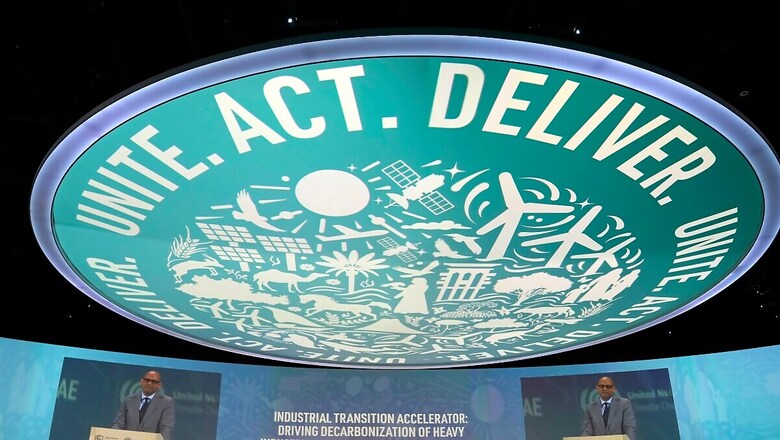
views
After 10 days of negotiations, the UN Climate Summit published a new text on the Global Goal on Adaptation on Sunday morning finally giving the much-needed push to recognizing the adaptation needs of developing countries at COP28.
The biggest climate conference of the year has failed to deliver any significant results on adaptation so far – a crucial area for developing countries. Unlike ‘mitigation’, which focuses on reducing emissions and remains at the centre of climate talks, ‘adaptation’ actions are usually pushed into the background as they are hyper-local and directed at protecting people who are already witnessing the impacts of climate change.
Established under the 2015 Paris Agreement, the Global Goal on Adaptation (GGA) is a collective goal that aims to “enhance adaptive capacity, strengthen resilience and reduce vulnerability to climate change”. However, there has been little progress on the front, mostly because adaptation actions are hyper-local and countries have struggled to define what “adaptation” actually means in the global context. The absence of a clear definition and universal metrics have been big roadblocks. The latest draft overcomes this obstacle to some extent by laying down a global framework and inviting countries to support its implementation and scale up their adaptation policies.
If adopted at COP28, this would guide national efforts towards adaptation with clear indicators and timelines, and also drive political action and finance for adaptation on the same scale as mitigation. The work on laying down the framework had begun in 2021 in Glasgow, where countries agreed to set up a two-year Glasgow- Sharm-el-Sheikh work programme to devise a universal framework for implementing the GGA.
NEED FOR ADAPTATION FINANCE
The text acknowledges the wide gap in adaptation finance, even though it falls short of addressing it effectively. A latest report of the Landscape of Climate Finance report released by Climate Policy Initiative shows that out of total USD 1.27 trillion in climate finance flows in 2021-22, only USD 63 billion was allocated for adaptation.
“There is an urgent need to scale up support to developing countries in implementing the specific adaptation targets currently under discussion, to safeguard communities from escalating climate impacts. Without urgent action, we risk exposing people to increasingly severe consequences, including rising seas, intensifying floods, and recurrent droughts,” said Harjeet Singh, Head of Global Political Strategy, CAN International.
“It is encouraging to see the GGA recognizing the need for more adaptation finance, and the importance of timeliness and predictability. The GGA’s implication is that India would need to increase domestic capital allocation for adaptation. India needs to set up a new fund with a broader mandate than the National Adaptation Fund for Climate Change to provide coverage for all aspects of adaptation and resilience. The government should provide regulatory and operational flexibility for such a fund to not only tap into government funding but also leverage domestic and global, private and philanthropic concessional capital and grants,” said Arun Krishnan, India Regional Programme Lead, Global Innovation lab in Climate Finance, Climate Policy Initiative.
In addition, India will also need to analyse, map and document the adaptation requirements in greater detail at multiple levels to ensure prioritization of projects and finances. Currently, the State Action Plan on Climate Change does not give a break-up of adaptation and mitigation financing required at states, according to experts.
A GLOBAL FRAMEWORK FOR ALL COUNTRIES
The framework also sets a target of 2027 for setting up multi-hazard early warning systems and calls upon countries to complete an impact, vulnerability and risk assessment by 2025 to feed into the national adaptation plans and nationally determined contributions (NDCs). It also urges countries to have a national adaptation plan in place by 2025 which is country-driven, as well as gender-responsive. “The GGA framework has evolved very well over the past week at the COP28. It now calls for a detailed approach for accelerating the action on adaptation with a focus on addressing food and water security, climate resilient infrastructure, health and cultural heritage,” said Vishwas Chitale, Senior Programme Lead – Climate Resilience, Council on Energy Environment and Water (CEEW).
The text also recalls the principles of equity and common but differentiated responsibilities and respective capabilities (CBDR-RC), in the light of different national circumstances – the primary focus of developing countries. However, there is still scope for improvement, say experts. “The section on means of implementation is still very weak in the text and it will be interesting to see a consensus building up on this, given differing views between developing and developed countries,” said Saransh Bajpai, Associate Director, Climate Programme, World Resources Institute India.
With just three days to go, the negotiators are reaching crunch time to finalize the outcome document. COP28 President Dr Sultan Al-Jaber held a late plenary on Saturday and stressed on his intent to reach a consensus by Tuesday morning. The two-week long conference will culminate on December 12 with the first-ever Global Stocktake (GST) and a set of legal decisions which will be binding on all the 195 countries which are signatories to the Paris Agreement.

















Comments
0 comment